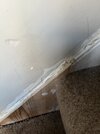Sorry, I meant to say “is there a technique to painting window panes”
Better to mask off each square or just paint and scrape off excess on the glass?
I don't use tape, but as a DIYer if might make sense. A down side of tape is that people then apply copious amounts of paint, when removing the tape it may pull the paint off the surface.
One could however use a sharp 9mm knife to cut through the paint line though.
Please do not use regular "white" masking tape if you plan to leave it on for a week or so. The UV light makes the glue go rock hard. Blue masking tape can be left on for much longer.
Blue Masking Tape | Tapes | Screwfix
Buy Blue Masking Tape at Screwfix.com. Over 40,000 products. The UK’s leading retailer of trade tools and hardware. Free next day delivery available. UK call centre ready for your call 24/7.










